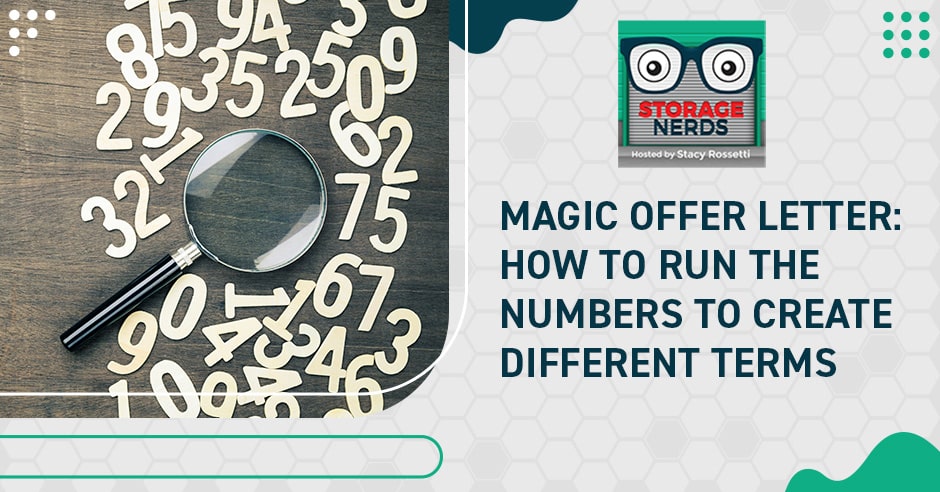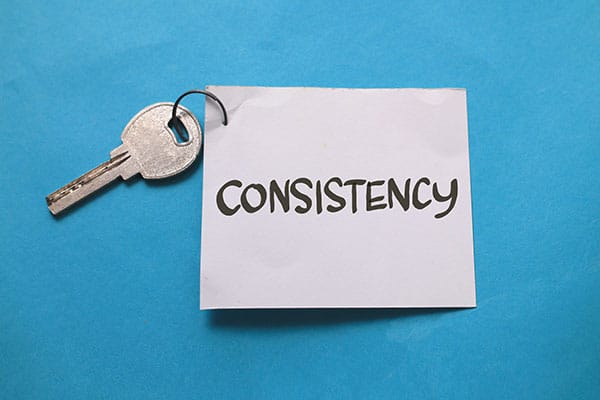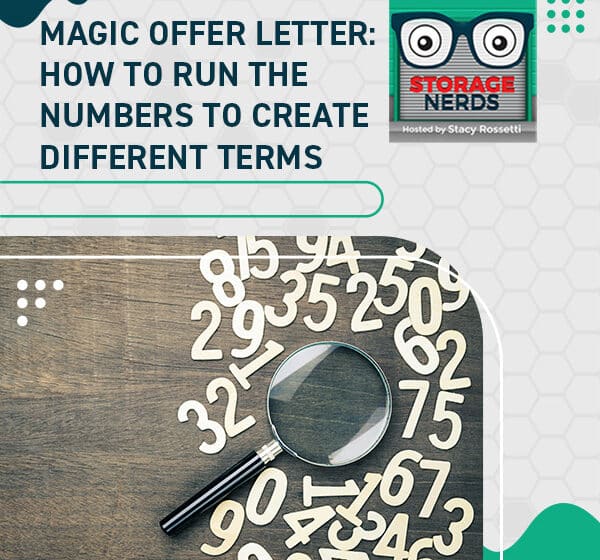
In this video, Stacy Rossetti walks you through the process of running numbers for your storage facility to create different terms for the magic offer letter. She explains the magic offer letter and why it is important for self-storage operators. She also shows how to calculate the different terms of the magic offer letter, such as the rent, deposit, and security deposit. As Stacy navigates into the topic, she offers tips on using the magic offer letter to attract and retain tenants. This video is perfect for anyone who wants to learn how to run numbers for their storage facility and create a magic offer letter to help them grow their business. So don’t miss this episode, and tune in now!
Connect with Stacy Rossetti here: www.stacyrossetti.com
—
Watch the episode here
Listen to the podcast here
Magic Offer Letter: How To Run The Numbers To Create Different Terms
We are closing on number sixteen. We’ve been trying to close this facility for a long time. What happened is the seller’s attorney got involved, and then also, my attorney got involved. When attorneys get involved, everything gets all screwed up. We were supposed to close this facility probably a few months ago. After two months of back and forth with attorneys and stuff getting involved, finally, we get to close this facility. I’m looking forward to that.
It is a $1.4 million facility. It’s in Carrollton, Georgia, which is a suburb West of Atlanta. We’re adding 175 doors. There’s a commercial building as well, too, that has five tenants in it. We have a commercial building that we’re adding to and then a whole bunch of tenants and stuff. It’s going to be a really good deal. I’m excited about it.
Buying real estate is not easy at all. It’s exhausting. We’re in the final stretch of trying to buy that facility. That will be number sixteen for us. If you guys don’t know, my team finds the facilities and funds it. That’s my job, finding and funding. My husband, his team take over and manage it. They’ve been gearing up to get ready to bring on all these new tenants.
It’s a severely mismanaged facility. You guys know that I buy severely mismanaged facilities. It’s supposed to be at around $1 a square foot. He has added about $0.50 a square foot. We’ll be able to double the value of the property, if not more, by increasing the rates and then getting the economic value of that property up.
The physical occupancy of this property is pretty good. He doesn’t have a lot of vacancies. The issue is that with the mismanaged facility, getting the people who occupy the units to pay is one of the hardest parts of owning a storage facility. 80% pay and 20% don’t pay. About 60% pay and 40% don’t pay, something like this. We’ll have to go through the process of getting them into our system and then also letting them know there is going to be a price increase.
Probably a lot of people will leave. We’ll also have to do a lot of auctions. It takes a good couple of months. This time until the end of 2023, it will take us that long to get all the contracts signed and get the auctions done. We closed on a property this time in 2022, and it took a good 6 months for us to clean the thing up and get it to where we could get all the bad tenants out and start getting new tenants in. It does take some time with mismanaged facilities.
That’s not stabilization. Stabilization is when you get it to 85% to 90% occupied. That’s when you could say, “I stabilized the property.” The first six months of this property are chasing tenants, getting them to get into the system, signing the contract, getting them to be able to make payments because have to get their payment information, and then cleaning the place up. On top of that, it is starting to auction off anybody that you can’t get ahold of and going through the auction process for that. We typically don’t do an auction process until 90 days after we own the property. It takes a good couple of months to even do an auction process. That’s why I say the first six months of owning a storage facility is a lot of work.
We were supposed to close on Monday. We didn’t close on Tuesday and Wednesday. It’s probably not going to close now. Cross your fingers, hopefully, soon, they will be closed. It should close within the next day or two. We are in the process of wiring money over. Wiring $1.4 million over is scary, too, with all the wire fraud and stuff. That’s a big thing.
I talked to my attorney and was like, “I’m going to wire you $1.4 million.” He was like, “That’s great.” I was like, “This is a big deal. There’s a lot of money to wire over.” He was like, “This is something that we wire every day. This is not a big deal.” I was like, “For me, it’s a big deal,” because we’re paying in cash. That is what we’re doing. I raised enough money to buy this thing. I raised that through our fund, which is the Self Storage Fund of America.
The owner did not want to owner-finance. Typically, with a mismanaged facility, I try to push seller financing. I try to get the owner to be the bank. In this respect, the owner did not want to be the bank. He was adamant. He wanted to get his $1 million. He’s going to make $1.4 million, but he is going to have to pay taxes and stuff, so he will make $1 million on the deal or whatever. Once he gets his $1 million, he’s leaving and moving to Costa Rica. He wanted to have that $1 million to retire.
Raise The Money
I couldn’t get him to seller finance, so I had to raise the money. I raised that through the Self Storage Fund of America. That is a 506(c) fund. The minimum was a $25,000 increment. I created a fund is what I did. It’s like syndication, but it’s more like you’re raising the money as a line of credit. I did a 506(c) fund. The minimum was $25,000. It’s for only accredited investors. Accredited investors mean that you have $1 million of net worth or more. That is how this works.
For the last couple of months or so, I’ve been pitching everybody to give me money for this so that I could pay this in cash. Raising $1.4 million, for me personally, is not easy, especially if you’re doing it in $25,000 increments. Think about how many $25,000 investors you have to have in order to raise $1.4 million. This goes for syndication. Syndication is typically when you have one property and you’re raising the money for that one property.
A lot of times in syndication, what you’re doing is raising enough money for the down payment. That person or that group is going to a bank and getting a loan. The loan is more money than you have. Let’s say I was going to buy this with a bank. It was a $1.4 million facility. With a bank, you need 30% down unless you get an SBA loan. SBA loans are very hard to get because you have to buy $0.50 on the dollar. I probably could have gotten an SBA projected-based loan for this, but then, I would’ve had to pay 10%.
SBA Loan
The SBA is the Small Business Association. They love storage facilities, but the thing is it’s a variable rate. That means it’s the prime plus 2% or something like that. Prime is 5.5% or 5.7%. I don’t know what it is. I can’t remember. You have to add 2% to that. On top of that, you also have points and fees, and then the interest rate is super high. It’s hard to get the numbers to work for a loan.
Small Business Association loves storage facilities, but it's a variable rate. Share on XIt’s hard to get a projected-based loan because you have to project what your income is going to be and how long it’s going to take. You have to do a business plan. You have to do a marketing plan. You have to do a whole bunch of stuff. I bought with an SBA projected-based loan. It’s not impossible, but it’s a lot of work.
What I did instead was create a 506(c) fund. What that means is I can pull a whole bunch of people’s money together in order to buy a property. For this one, I paid with cash. That means I had to raise $1.4 million in cash. That’s a lot of $25,000. An investor could put in as much money as they want. They could put in $100,000 or $200,000. I have people that are putting $250,000 in or $100,000 or $150,000 in.
People are putting in $25,000 or $50,000, which is typical because they’re like, “I want to test you out. I want to see if you can do this. If you could do this, maybe on the next deal, I’ll give you more money.” I’m trying to build their trust. If they’re putting in $25,000 or $50,000 typically, that is a lot of investors to be able to get to $1.4 million.
Over the course of the last couple of months, I was pitching. For this, I paid cash, but if I wanted to go and get a loan from a bank, I would have to put maybe 10% to 15% down for this SBA loan. If I had to get a conventional loan. A conventional loan is going to be 25% to 30% down, and then maybe a little bit lower interest rate. It’s not that much lower. Let’s say SBA’s interest rate is going to be maybe 8% to 10%. Depending on the type of loan you get, depending on the lender, and depending on your experience, this is where you’re at. Conventional is probably 7% to 8% for a loan.
When I try to buy a $1.4 million facility, this is the thought process that I’m having. “How am I going to be able to afford this?” This is my thought process. You have to always make sure that the numbers work with your financing. What I said is that I can do a cash loan, SBA loan, or a conventional loan. We could add another one which is owner financing.

When I’m thinking about how I’m going to buy this property, this is the way that you’re going to buy it. It is one of these unless it’s a major, huge, big deal. If it is $3 million-plus, you could do a couple of other different things. This is us. We’re trying to buy our first property. For a $1.4 million deal, it is honestly not that much for a facility. It doesn’t get you that much. It got me 175 doors plus commercial space. That is what it got me.
If I’m going to have cash to buy this property, then I personally need to have $1.4 million of cash. Nobody has this much. That means if I don’t have it myself, then I can get it from partners. I could say, “We each put $400,000 on our way. We each put in $300,000. We each put $200,000 in.” You can partner and create a company. You guys can all buy this property together, or what I can do is exactly what I said. I can raise the money.
You can raise the money by syndicating, which is one deal at a time, or I could do a 506(c) fund, which is for accredited investors. You create the fund, the PPM, the subscription, and then you raise the money. A 506(c) allows you to pitch to strangers. That’s what allows you to do to raise the money. I could do a 506(b). A 506(b) says that you can only pitch to your network. These are non-accredited investors, which means anybody else. The rule is that you can only put in so much money of your net worth. It is 1% or 10%. It’s only so much of your net worth.
This is for a non-accredited investor. If you are a non-accredited investor and you have money, let’s say that you don’t have a net worth of $1 million. You may have a rental property or something like this, or you don’t have anything but you do have money. Let’s say you have $50,000 or $100,000. You cannot go and invest $100,000, which is all your money, into one deal. The SEC does not want you to do this because they want to protect you. There are what you call 506(b) funds. A 506(b) allows you to put $25,000 into a fund if you want to do that or $50,000, depending on what your net worth is.
I get this question a lot too. It’s like, “I’m not an accredited investor. I don’t have a net worth of X amount of dollars or $1 million-plus, but I want to invest my money in a fund.” I always tell them, “Look for a 506(b) fund.” I’ve done 506(b) syndications before. That is where you’re going to be protected in this type of deal right here. The fund administrators or the fund managers are going to be protected as well too.
I could have gone and done any one of these routes. I could have used the money myself and used my own money. I could have partnered and brought money somehow that way, formed a company, and then we could have all gone and bought this property together. I could have syndicated the deal myself and said, “This is that one deal that I’m going to be syndicating. I’m going to raise the money for this.”
I started a 506(c) fund, which means that I can pool everybody’s money together and I can also pitch to strangers. I’m allowed to talk about my fund to you guys even though we don’t know each other personally. A 506(b) fund is a non-accredited in-network. Let’s say you have a lot of people in your network that have a lot of money. They all said, “If you do something, I’ll put some money in. You could do this as well, too.”
These were my options for cash. I was like, “What other options do I have?” The other option that I have is the SBA route. For SBA, you typically have a 10% to 15% down payment. You have the interest rate, which is going to be prime plus, 1% to 2% of interest rate. You’re going to also have all these fees. SBA has a ridiculous amount of fees. We closed on a deal a couple of months ago and it was $70,000 in deal in fees. It was a ridiculous amount of fees. It was a $2.5 million facility, but it was a lot of fees.
You have the down payment, interest rate, and the length of the loan. It could be a fixed rate for twenty years. There could be a balloon of five years. You could be amortized over 10, 20, or 30 years. I have a student that is getting a loan. It’s a 10% interest rate. It’s fixed for 30 years. Could you imagine? That’s a hard money loan, but that is what SBA is doing. That is what that is looking like. It’s a fixed rate at prime plus 2%. It’s a long-term loan. SBA is variable. The interest rate is variable.
Conventional is where you get the fixed terms. Conventional is where you’re going to put 25% to 30% down or more sometimes. Conventional is 25% to 30% down, and then the interest rate is going to be between 7% and 8%. This is not a few years ago. This could change in 2024. The 7% to 8% interest is fixed. There are fees, but it’s not too bad, honestly, with the fees and the length. The fees are high here in the SBA. In conventional, the fee is low, and then the length is going to be twenty years. The SBA most likely will have a balloon, too. Sometimes, you can get fixed on SBA loans. This depends on the lender.
Owner financing is where you get the owner to be the bank. A lot of owners are open to this. If you’re not offering owner financing, then you’re missing out. We’re getting a lot of deals that are owner-financed. The owner financing is the same thing. Owner financing is you’re going to have a down payment. It depends on the owner. We typically start with 10% down and we’ll go up to 20% down. That’s where we’re at.
We have a deal that we’re in the process of getting owner-financed. It’s a $1 million purchase price. The owner wants 20% down, and then they’ll owner finance the rest at 5.5% interest, which is a very reasonable interest rate. You have a down payment. It could be anywhere from 10% to 20%. The interest rate is typically lower. You want to start with a lower interest rate when you’re doing owner financing. You’re going to be anywhere from 5% to 6%, I’ve had a couple of people say 6.5%. They want to be at 6% and they go, “The interest rate is a good deal.”
I closed on one a couple of months ago in Florida. That one was 6% interest. The highest I had was 6% interest. Shoot for 5% to 6% interest. You can also amortize these. Interest rates can be amortized. That means you could spread it out over a 20-year period or a 30-year period. For SBA, it is typically going to be twenty. For conventional, it could even be up to 30 sometimes. The 20 to 30 is good. This is typically around 20%, but you can go up to 30%.
This is the thing. We’ll have an owner like this million-dollar one. We run the numbers and the value of the property. Let’s say it is $850,000 and that they want $1 million. This is typical. We’ll say, “If you owner finance, we’re willing to pay a little bit more. If we pay you $1 million, we want a lower interest rate and we want that to be amortized over a 30-year period.” The reason that you do this amortization over a 30-year period is that you want your monthly payments to be lower. We’ll pay more money for that property. We’re okay with paying that.
The truth is you’ll pay less money for a property if you can get that property owner financed and you can get these terms fixed and worked out. You can look at your cashflow. You can typically get a better deal in the long run if you get owner-to-owner finance. The good thing about getting owner-to-owner finance is you educating them and letting them know, “If I go to a bank and get a loan, I’ll be paying the bank all the interest. Why don’t I pay that interest to you? Not only am I going to be paying a little bit more for this property, but on top of that, you’re going to be making money on this interest as well.” That’s how we go about talking about it. We explain and educate them.
Offer Letter
Also, in our offer letter, we make sure that we share that. This is what we’re sharing in the offer letter. I’ll give you an example of that here in a minute. The truth is do you want to pay the bank that or do you want to pay the owner that? Why don’t you make the owner wealthy? Why do you want to make all the banks wealthy? That’s what I tell all of them. You have to educate owners because a lot of owners don’t understand these concepts as well, too.
You can get that amortization longer. You could say, “If I pay you 6% interest over 20 years, my mortgage to you is going to be this, but my cashflow is not going to be enough for me to be able to run this property. Why don’t we amortize the mortgage that I have to you over 30 years and decrease it a little bit so that I have this better cashflow?” That’s the purpose of using the tool for amortization. It is so that you can get that mortgage down so you can get your cashflow higher. Figuring out your interest rate and figuring out your years of amortization is super key in what your cashflow is going to be. That’s a big tool.
For owner financing, you have to talk to the owner and say, “How much time do you want to give me in order to stabilize this property and hold onto it?” For instance, I had a coaching call with a student right before this. He’s talking to an owner. He was like, “I’m getting an owner finance,” and the owner was like, “I want ten years. I want that monthly payment every single month.”
The owner understands the concept that they’re going to be getting paid every single month for doing nothing. Instead of giving it to the bank, why not give it to the owner? He’s like, “I want to make, $4,000 a month. I’m used to making right now $8,000 because I’m managing it myself and I’m doing everything myself. I’m okay with $4,000. Run the numbers and try to get me to where I can make $4,000 a month.” The monthly payment is super important for owner financing and for talking to the owners.
The monthly payment is super important for owner financing and talking to the owners. Share on XThe length typically is 2 to 15 years. I have 1 that’s a 12-year, and I have 1 that’s a 2-year. I’ve had a gamut.
I have one guy. I was like, “You’re going to have to owner finance this to me. If you do not owner finance this to me, I can’t buy this.” There was no bank that was going to finance it because it was so severely mismanaged. He was like, “Fine. I give you two years. That’s what I’m going to give you.” I was like, “I’ll take it.” That gives me two years to get in and stabilize. In two years, I’ll be able to create tax returns that I’ll be able to show to the bank and hopefully refi out in two years.
You can talk about all these terms. You can convince them anywhere. 2 to 15 years is typical for owner financing. In the case of me buying this $1.4 million facility that we’re closing on, I went through this not only as we’re running our numbers but also with the owner as well too. I was trying to convince the owner to get me into owner finance and make the offers and show the numbers that way versus doing the cash or going to the bank and getting a loan.
Internally, I was like, “I could raise $1.4 million. Let me try to raise the money. I’m going to put it into the fund and I’m going to raise the money myself.” Over the course of the last few months, I’ve been pitching. If you want to do a lot of deals, a lot of storage facilities, or any type of property, if you want to buy a lot of property, a bank is only going to help you so much. The truth is interest rates and banks are not working. It is very hard to get bank financing because the interest rates are so high. Plus, the owner’s purchase prices are so high that the numbers are not meshing well.
It's difficult to get bank financing today because the interest rates are so high. Share on XWhat I’ve noticed, too, is when I talk to banks and find a deal that would work with the bank, the banks are eager to work with you. They’re trying their best. I’m working with a couple of banks and they are fighting over me. I’m at 7.135. I’m at 7.2.1. The interest rates are going down. It looks like everything’s going to be changed. They’re, on a daily basis, letting me know, because you can’t lock your rate until a certain time, what the interest rates are, and stuff like this.
If you can find a deal where a bank is willing to finance it, you can push and negotiate with the bank because they’re hardly closing any deals. It’s hard to close a deal, so all these lenders are super hungry for deals that work with them. In this case, me personally or where I’m at, I said, “I’m going to do a 506(c). I’m going to raise the money, and I’m going to buy this thing with cash.” The numbers look amazing with cash because it’s cash. I’m like, “Let me see if I can raise the money.” Over the course of the last couple of months, I have been pitching.
Raising money is not easy at all, but the truth is if you’re consistent with it and you’re talking to investors on a regular basis, then you are going to start getting into this routine. Every Thursday, I pitch my deals. It is every Thursday except for the last couple of weeks because I’ve been on vacation. That is how I’m raising the money. Everybody knows if they’re interested in working with me, they can hop on my pitch every Thursday.
I don’t know if you guys saw the post that I had in the Facebook group. If you haven’t joined the Facebook group, it is the Super Simple Self-Storage Facebook group. I happened to be setting something up in my calendar. Since 2020, when I started using AppointmentCore, which I use AppointmentCore to set all my appointments, I have had over 3,000 meetings in the last couple of years. That’s 1,000 meetings a year that I’ve had.
Those meetings for me are for investors. Every week, I’m meeting with several investors. I meet with my coaching students, and I’m coaching on a regular basis. I meet with my team almost on a daily basis. I’m meeting with somebody in my team to have meetings, and then the owners. Right after this session, I have two owners that we’re meeting.
I tell everybody, “If you want to raise money to do deals, how many meetings are you having? Do you have times that you can pitch your deals or whatever you’re doing?” Consistency is key to raising money. Every Thursday at 1:00, I pitch all my deals to see if I can raise money. I’m having a lot of meetings to do this, but I raise the money and raise cash for this deal.

I’m not going to get into the numbers and stuff. Once I close on the deal, I’ll get into the numbers. I’ll show you guys the deal and stuff like this maybe on the next. If I close it, then maybe soon, I’ll do the numbers and stuff for it. I wanted to give you an idea of how I bought this facility and what’s going on in the market trying to buy it.
A lot of people are dropping out of the property game. It’s too hard to find deals. I saw a big guy posting, “I haven’t bought anything in the last year.” I’m like, “I bought six deals in the last year.” The reason why is that I’m able to pay cash for these deals. That’s why. The person who posted out only goes to banks. That’s it. He does not do any owner financing. He doesn’t believe in seller financing. He doesn’t buy anything with cash. He likes to leverage his money.
He’s like, “I want to leverage it.” Guess what? You can’t leverage with the bank. It’s not working. The truth is if you don’t have cash or if you don’t know how to raise the money, or if you’re not even offering seller financing, you’re missing out on some amazing opportunities out there. You have to understand and know all of this in order to be able to buy storage because it is very difficult.
If you don't have cash, know how to raise the money, or offer seller financing, you're missing out on some amazing opportunities. Share on XI wanted to show you the owner financing. When you talk to an owner and you’re going to be making an offer, remember, I said the monthly payment, the length of the loan, the interest rate, the down payment, the balloon, and amortization. I don’t know if you guys have checked out the Deal Analyzer. I offer my Deal Analyzer for anybody to purchase. Inside the Deal Analyzer, what I am talking about here is what we call financing inputs. The financing inputs are where you get to play around with all the different types of financing scenarios out there.
On my Deal Analyzer, we have five different ways for you to run numbers. You can do a dropdown and you can change it. You can run the numbers cash. You can run the numbers with SBA, conventional, owner financing, and all kinds of different ways of running the numbers. You want to make sure that you have something like that. Whether or not you use my Deal Analyzer or something else, you want to be able to run your numbers in different kinds of scenarios. We do that on my Deal Analyzer. In the tab, it’s called Financing Inputs.
These financing inputs that you’re putting into the Deal Analyzer, what it does is it creates your offer letter. Inside my Deal Analyzer, you have a way of making an offer letter. You don’t have to use my Deal Analyzer to even do your offer letter. The offer letter looks like this. It will say, “Dear blank. Thank you so much for giving me the opportunity to put this offer in at your address. We’ve run the numbers several different times and this is what we’ve come up with.”

The way that you put the numbers into the financing input generates your offer letter. Your offer letter is going to look like this. The letter says, “Please take a look at all the different offers. We’ve created four different offers for you. You can check them all and see which one worked the best for you. Also, know that this is also up for negotiations. If you can think of a different scenario that might work for you, let us know. We are open to talking and discussing with you any type of scenarios that you can come up with.” We buy a lot of deals in this way. We meet with owners on a regular basis. If you are reading what I am telling you and thinking, “This sounds like something I might want to do, but I would change this,” then let us know. Let’s hop on Zoom and discuss it.
That’s what the letter says. When we send the offer over, that’s what the email says as well, too. I’m going to tell you that I meet with owners on a weekly basis. It will say cash, and then it says bank financing, and then it says owner financing. You will have four different offers. You could have two owner financing deals, a bank financing deal, cash, or however you want to set it up. Bank financing and owner financing are exactly the same. It doesn’t matter what you call them. You call them whenever you want at the top.
You have the monthly payment, the length of the loan, the interest rate, the balloon, the down payment, and the amortization. You are spelling those out. It’s a table that’s offering four different offers at the same time. You don’t want everyone to send over an LOI for one number. I get LOIs all the time. I don’t understand the whole LOI concept. This concept is what’s going to get the wheels of the owner turning. When you send them over an offer letter that has 4 or 5 different offers on it, that’s what’s going to get the wheels turned. It is not an LOI for one number and that’s it and it doesn’t show anything else. They’re like, “Do I want to take that number or not?” You want to make sure that you’re creating the conversation that happens. That’s what you want.
The most important part of each deal is the profit to the owner and the final number total. That’s what you’re putting in these. Not only do we show what they’re making on a monthly basis, what the interest rate is, what the length of the loan is, what the down payment’s going to be, or what the amortization is going to be, but we also show them how much money they’re going to be making. That is the number that they’re going to want to know.
If I pay cash for this and it is $1.4 million, I’m going to be making $1.4 million. If I get finance, I can’t pay $1.4 million because the numbers don’t work. The numbers don’t work at $1.4 million. I’m going to have to pay $1.1 million. That’s where the numbers work. This is the purchase price. At the top, it always says purchase price. I’m going to pay $1.4 million in cash.
For that same property, if I went to a bank and got a loan, I would not be able to pay $1.4 million for it because the numbers don’t work. Remember, I’m running the numbers at 10% down the interest rate. That brings the number down to $900,000 if I’m going to go and get an SBA loan. If I’m going to get a convention loan, I could probably pay $1.1 million for this property.
If you owner finance this deal to me, I’ll pay you $1.6 million or whatever it is. It could be $1.5 million or $1.6 million. We always pay more money if it’s owner finance because we know that the interest rate is going to be 5% whereas cash is nothing. The interest rate here is 10%, and the interest rate here is 8%. I’m okay with paying more because I know my interest rate is going to be a lot different and a lot lower.
Let’s say you’ve owner-financed this for ten years. You’re going to make $400,000 or something like this. You’re going to make $400,000 if you owner finance this. In total, you’re going to make $1.9 million on this deal. You’re showing that in this table. That is what you’re doing. Whereas over here, you are only going to be making $900,000 because that’s it. You are buying it for $900,000. Here, you’re only making $1.1 million because that’s it. The bank is going to make all that money. You’re not making any money on these two deals. With cash here, you make $1.4 million. You show that in a table.
Our Deal Analyzer does this for you automatically. All you have to do is print the letter out and then hand it over to the owner. The truth is you could create your own letter and do this yourself. You’re coming up with a whole bunch of different ways to make offers. I always tell everybody, “Make a cash offer, a bank financing offer, and then a couple of owner financing offers. It is so that you are getting the wheels turning for the owners.” You’re getting the wheels turning and they’re like, “If I do owner finance this thing, I could make a couple hundred thousand dollars more.” That is how we get a lot of those owner finance.
A lot of times, it doesn’t work out and they say, “I want the $1.4 million cash,” which is what the guy said that we’re buying from. You want to try and show them this because it is your job to educate the owner on what his options are. The owner’s one option is to sell it and make money on it. You sell it and get the one thing. I’m saying most do not understand these concepts. This is what we did.

For the one that we’re closing on, we sent the offer letter over. We ran the numbers in the Deal Analyzer and put all the inputs in. You put all the inputs in, and then in the end, we came up with an offer. Maybe it was $1.2 million or $1.3 million. He came back and said $1.4 million or whatever it is. We negotiated that. These are all financing inputs that you are running numbers on in order to create your offers. This is what your offer letter is going to look like. It will say, “Let us know. Stacy.” You send this over to them. That is what we do so that they can decide if they want to work with us.
I’m telling you. I call this the magic offer letter. That’s what it’s called. You guys can all do this to yourself and create this yourself or you can go to my website, which is StacyRossetti.com. You can buy my Deal Analyzer. It will create this for you when you’re running your numbers. Also, with my Deal Analyzer, there’s a whole bunch of videos that go with it. I’m going to walk you through the whole process of feeling it out.

If you are having trouble trying to figure out how to analyze self-storage, I highly recommend that you get my Deal Analyzer because that is going to walk you through how to analyze deals. That’s what it’s for, is to analyze the deal for you. It has green is a good number and red is not a good number. It shows you all the different financing inputs that you do. This number’s not going to work. These deals are not going to work. You have to change the numbers and stuff.
You want to go to StacyRossetti.com. That’s where you can get the Deal Analyzer. It’s 4.0 We have upgraded it four times. If you want to go through the course, you’re more than welcome to buy the course, which is Super Simple Self-Storage. Somebody asked about the Facebook group. The Facebook group is called Super Simple Self-Storage.
If you can join the Facebook group, get the course, get the Deal Analyzer, and then come to these Wednesday sessions, I call that the triad. That’s like the course, the Deal Analyzer, the Facebook group, and then the Wednesday training. If you can get all three of these, I’m telling you within the next couple of months, you’ll be rocking and rolling. In fact, I got a post. He was like, “I bought a couple of deals. Thank you so much for your course.” I was like, “Thank you so much.” I’m going to try to get him to come on and talk about it. He’s like, “I went through your course. I got your Deal Analyzer. I’m buying my second storage facility right now.” I was like, “That’s awesome.” Stacy Rossetti is where everything’s at.
I had a couple of other questions. The Deal Analyzer does not come with the course. It’s separate. These are live sessions, so you have to show up. I record them, but I give them to my students and storage nerds. If you want a coach, check out StorageNerds.com. That’s where I’m coaching and holding your hand and stuff if you want to do that.
If you want a coach, check out StorageNerds. Share on XHopefully, that gives you an idea of all of the financing inputs. It gives you an idea of how we run numbers. Overall, visually, this is what I’m thinking when I get a deal or when I find a deal, I’m like, “What are the best financing terms for this deal? Am I going to have to raise money? Am I going to try to get the seller to finance? How am I going to do that?” What are our offers going to be? That’s what I walked through. I was raising money and running different scenarios of financing terms so that you could make the offer. That was the purpose of this training.
I do these every Wednesday. You can hop on every time. This is a new session that you can hop on and listen to. When raising privately, how long are the investors in for the rise? It could be any time. Typically, I do two years-plus but my investors are five years typically. You could do whatever feels comfortable for the investor.
What do they feel comfortable with? If they only want to do a year, are you going to pass them up because they only want to do a year? You are like, “Let me borrow your money for a year. Let me figure out how I can get you your money back in a year.” The word left of the pyramid is Wednesday’s training. The Wednesday training is what it is. Wednesday’s training is the course, the Deal Analyzer, and the Facebook group. That’s my triad. That’s Stacy Rossetti teaching self-storage and triad. I got to meet an owner. It’s one minute. Take care. I’ll talk to all of you soon.


